I was hoping for Wilberforce to come running up to kick the football and then at the last minute Brutus pulls the football away causing Wilberforce to land painfully on his back just like Charlie Brown.
Sunday, November 30, 2014
Friday, November 28, 2014
997: Thanksgiving Poison Coma
Over the last couple of years, Gladys has been shown to be a good cook so when Brutus makes fun of her culinary prowess, it always feels disingenuous. But what's really interesting is that it looks like they are eating the pies first.
Clearly the food wasn't terrible-tasting since Brutus ate too much yesterday. Although I guess it's possible that Gladys poisoned the food. Maybe that's why they started with the pie and everybody got their own!!
Wednesday, November 26, 2014
Tuesday, November 25, 2014
995: But Brutus Doesn't Have a Cell Phone
Brutus strikes me as a person who wouldn't want to leave a voice mail. I hate leaving messages on answering machines. When I have to leave a message, my hands get all clammy and I sweat and I get dizzy. One time I wound up in the hospital...
Monday, November 24, 2014
994: And Who Is Gladys Looking At?
I weighed myself last night and I was very disappointed with the results. I know what my New Years Resolution is going to be for 2015.
Anyway, what's Brutus drinking? It looks like chocolate milk. When is Gladys going to eat? She's still in her apron. Is this lunch or dinner? Why does Brutus have to beg his wife for seconds? This strip isn't very well plotted out.
Anyway, what's Brutus drinking? It looks like chocolate milk. When is Gladys going to eat? She's still in her apron. Is this lunch or dinner? Why does Brutus have to beg his wife for seconds? This strip isn't very well plotted out.
Sunday, November 23, 2014
993: Shut Up and Get My Doughnuts
I love doughnuts. I do not like ordering doughnuts. I always feel like I'm ordering too many or getting that one doughnut that they make but no one ever buys so when I order it their thinking: "Does he really like those or is this his first time eating doughnuts?" I don't know. I don't understand why ordering a simple doughnut can fill me with self-conscious anxiety.
Saturday, November 22, 2014
The Douglas County Poor Farm
The poor house was a social institution that dates back to 1697 when the first English workhouse opened in Bristol, England. The poor house came along due to parameters set by Queen Elizabeth I in 1601 which called for taxes to be collected and the creation of almshouses for the aged, infirmed, mothers of illegitimate children and children incapable of work. It was important legislation because it established state responsibility for the poor and began a standard by which care should be delivered.
The English law followed colonists to America and the first public almshouse in America was started in Philadelphia in 1731. All residents—lame, sick, vagrants, aged, children, unmarried mothers, blind and able-bodied poor—were housed together and worked for their keep. In Midwestern states, the almshouses were typically called “poor farms” and it was run as exactly that. Male residents tended animals and crops and performed routine maintenance. Women took care of the house and household chores.
The first poor farms in Kansas were started in Leavenworth and Douglas Counties in 1866. By 1899, eighty of the 105 counties had poor farms. The poor farm in Douglas County was first organized in 1866 when the county commission minutes showed of purchase of a 160-acre farm from George Sterns for $2,200.
The 160 acres was located one and one quarter mile south of 31st Street and Haskell Avenue on the south side of the Wakarusa River. The legal boundaries of the property were the northwest quarter of Township 13, Range 20 and Section 20 and according to a 1857 map of Douglas County, the property was owned by R.P. Moore at some point the property came under the ownership of George Sterns.
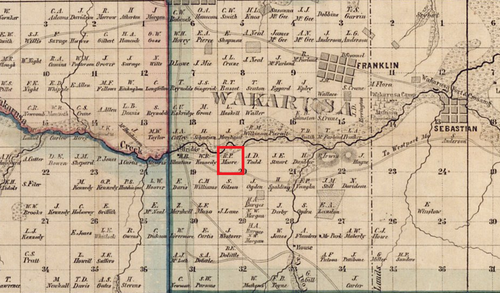 |
| 1857 Plat map of Douglas County. R.P. Moore land highlighted. |
Census records from 1870 list twelve residents of the farm. Two males were listed as “farm laborers” and a woman was “keeping house.” Six ‘paupers,’ ranging from 2-year-old Willy to an 80-year-old man, were listed as illiterate, and one was designated an ‘idiot.’ People on the farm worked if they were able to. They maintained the house, tended crops, fed livestock—which mainly consisted from cows, pigs and chickens—and women usually did house work including cooking, cleaning and laundry.
In 1887, the Poor Farm’s superintendent was a Mr. Dodge who was described by some as a “common drunkard” and “a profane and brutal man.” When an aged Irishman died at the farm and was buried unceremoniously in the farm cemetery on the bank of the Wakarusa River, George Hollingberry expressed his unhappiness with the neglect and mistreatment of the county home to the Lawrence Daily Journal and county commissioners. While several people testified that Mr. Dodge was a good farmer, they still felt he should be removed as superintendent of “The Home.”
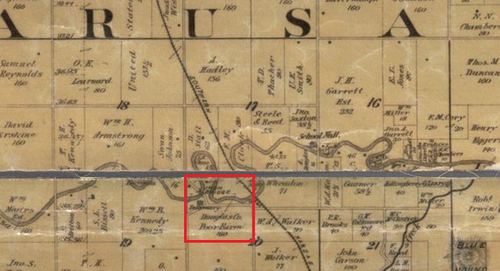 |
| 1887 Plat map showing the Poor Farm property in red. The main road to the Farm veers to the southeast before crossing the Wakarusa River over an iron bridge. |
A list of names recorded by the poor farm and submitted to the Douglas County commission shows that the poor farm assisted 109 people between 1909 and 1910 and this was in addition to the people whose residence was at the farm. Most of the patrons were from Lawrence but Lecompton, Eudora and Baldwin City were represented as were Lone Star, Lecompton Township and Vinland.
One of the more interesting names on the list is a Mrs. Mary Henderson who doesn’t have an address listed next to her but “Cocain Mary.” From what I found in newspaper archives, “Cocaine Mary” was an interesting character in Lawrence. Mentions of her in the various newspapers report her many arrests due to drugs and drunkenness. In 1910, she was shot at a party in Bloomington but it was unclear whether someone shot her or she shot herself. After accosting people heading to the Santa Fe Depot at 7th and New Jersey Streets, Mary was arrested and put on trial to determine if she should be remanded to the custody of the county. She was declared unfit to care for herself but, having no relatives and being unable to find anyone to take up the burden, she was released back into society. She is listed as being arrested again with a “Mexican friend whose name can’t be written” for indecent conduct. After that incident, news on “Cocaine Mary” ceased.
Deciding that it was time to expand the poor farm, county commissioners accepted the construction bid from John H. Petty of $22,944.00 to construct a two-story, brick structure with large pillars in front. Commissioners formally accepted the building on March 13, 1911 finding it “according to contract in every respect.” The old frame house was torn down.
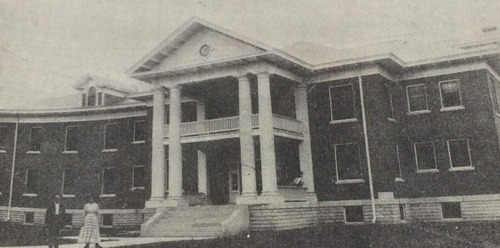 |
| 1911 Douglas County Poor Farm |
On March 15, 1927, a barn was destroyed by fire. W.J. Welshimer had been dismissed from the farm earlier that day and was later convicted of arson in the fourth degree. When he appeared for sentence at the jail, he stated “you wouldn’t keep me at the County Home, so I had to fix it so you would keep me some place.”
Aside from the occasional news report, life at the poor farm was quiet and peaceful. The farm provided most of its own food and raised livestock but tragedy struck in the early morning hours of April 11, 1944.
Superintendent George Hoskinson was awakened by the screams of two elderly men in the basement. George rushed to fight the flames while his wife went to a nearby farm to call the fire department. By the time the fire department arrived, flames had already engulfed the building. Hoskinson and six other employees were able to rescue the 26 residents. Eight residents burned to death in the fire. Mr. Hoskinson said that he helped one inmate out twice but she returned to the building and died in the flames. Another man, 69-years-old, was taken to Lawrence Memorial Hospital with both legs fractured having either fell or jumped from a second story window.
The fire could clearly be seen from Lawrence and later that day, Coronor C.B. Ramsey assembled a jury to visit the ruins of the home to gather evidence and to remove the remains of the deceased. With the help of the Red Cross, inmates were cared for at the Community Building at 11th & Vermont Streets until arrangements could be made for their care. Fire Chief Paul Ingels surmised that the fire started in a fusebox. County Commissioners also announced the next day that a small farmhouse would be built southwest of the poor farm ruins using salvageable material from the gutted building. The county sold the livestock and equipment and finally the land in 1946.
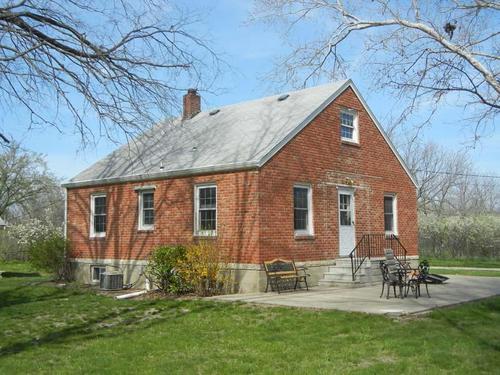 |
| The farmhouse built from the ruins of the Douglas County Poor Farm, circa 2013. Photo by Dale Nimz. |
Lucius H. Perkins was born in Racine County, Wisconsin on March 5, 1855. His parents, natives of Onondaga County, New York, were among the pioneers of southeastern Wisconsin. Perkins ancestry appeared as early as the tenth century and possessed large estates surrounding Ufton Court in Berkshire. The first Perkins to come to America was John W. who arrived in 1631 aboard the Lion and became a member of the Massachusetts Bay Colony at Ipswich. He later moved to Norwich, Connecticut where they remained for nearly 200 years when they moved to New York.
In 1877, Lucius graduated from Beloit College and moved to Lawrence where he became a student of law in the office of Judge Solon O. Thacher. After two years, he became a member of the first graduating class of the University of Kansas School of Law. He was one of the first to be appointed on the State Board of Law Examiners and retained that position until his death.
On May 15, 1882, Mr. Perkins married Clara Morris. They had four children, Bertram (1883-1887), Clement (1885-1966), Rollin (1889-1993) and Lucius J. (1897-2003). Mr. Perkins was fond of travel, devotedly attached to his home, loved the companionship of his fellow men and opened his home, a stately house he named Ufton Court, after his ancestral home in Berkshire, designed by John G. Haskell, 25 rooms, three-stories with a red tile roof and decorative tower, for all the neighboring boys. Mr. Perkins died suddenly at his home on June 1, 1907 from a fall at his house.
 |
| 1907 Lawrence Daily Journal photograph of Ufton Court the day after Perkins died. |
After Perkins’ death, the house was sold to the Alpha Tau Omega fraternity. During World War II, the house was renamed Victory Mansion and was a home for employees of the Sunflower Ordinance Plant in DeSoto. The county bought the house the day after the fire and in September of that year, the Douglas County Convalescent Hospital opened with 31 beds. Through the years numerous additions would be added on but the building had problems.
“It wasn’t what you would call a safe place for old people,” Douglas County Commissioner Walter Kampschroder remembered. “[T]he state health department got to checking and […] they were putting quite a bit of heat on us,” he said. On November 4, 1958, voters narrowly approved the construction of a new county nursing home. Two years later, voters approved the sale of the old home which was purchased by the Medical Arts Center and razed in 1962 for a parking lot.
The Valleyview Care Home opened in April 1961 at 2518 Ridge Court with 51 beds. The county leased the home to private operators and paid a monthly fee for all county partners. In 1975, commissioners were urged to return as the operators of the home since “maintaining […] profit was the prime concern of […] private operators.” The county took charge of the home the remainder of the time it was open.
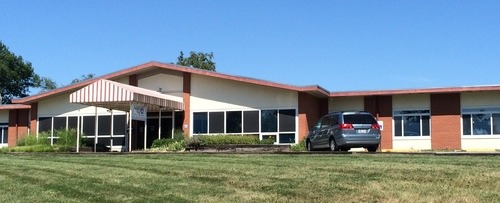 |
| The United Way Building, formerly the Valleyview Care Home, in 2014. |
In 1996, the United Way of Douglas County purchased the building to use as their offices along with the offices of numerous other charities such as the Red Cross, Girl Scouts, Big Brothers Big Sisters and Tenant to Homeowner. The Poor Farm is marked today by the farmhouse built in 1944, a barn and silo on the south side of North 1175 Road, a chicken coop and root cellar.
The Poor Farm Cemetery and Deaths
The Douglas County Poor Farm Cemetery was “situated on the banks of the Wakarusa River in a narrow strip of land between the river and the road”, was supposedly unmarked and used throughout the years as a cow pasture where the land was desecrated by rooting pigs and the tramp of horses and cows. The exact location of the cemetery is unknown and it’s suggested that it no longer exists due to the change in the Wakarusa River’s channel.
The only cemetery records for the poor farm exist in mortuary records from C.W. Smith. It shows only the burials that C.W. Smith Mortuary handled for the poor farm. Known burials in the Poor Farm Cemetery are:
- Joseph Franklin, buried Dec. 16, 1893, aged 64
- Infant Furgason, buried Jan. 4, 1891, no age given
- Child Hattan, buried Apr. 28, 1893, no age given
- Infant Edwards, buried Nov. 25, 1901, stillborn
- Minnie Anderson, buried Jan. 19, 1894, no age given
- Daniel Barkley, buried Jan. 23, 1895, no age given
- Mrs. Lowe, buried Oct. 21, 1891, no age given
- Carrie Low(s), buried January 1893
- Unknown Sukey, buried Feb. 11, 1891
- Unknown Jackson, buried July 3, 1892
- Child of Carder, buried Apr. 22, 1893
- Ora Wright, buried May 10, 1892
- Mrs. Albert Bebout, 86, Lawrence, buried in Oak Hill Cemetery, Lawrence
- Mrs. Ida Clark, 80, Lecompton, buried in Maple Grove Cemetery, Lecompton
- Miss Elizabeth Whitelaw, 76, Topeka, buried in Oak Hill Cemetery, Lawrence
- Peter Luzius, 83, Lawrence, buried in Oak Hill Cemetery, Lawrence
- Fred W. Plateman, 88, Big Springs,
- William St. Clair, 88, Big Springs, Maple Grove Cemetery, Lecompton
- Isaac Tabor, 71, Lawrence,
- Lafayette Tabor, 82, Lawrence, buried in Beulah Cemetery, Colby
The Complete Tombstone Census of Douglas County, Kansas Volume 2 by Jean Snedeger, Douglas County Genealogical Society, 1988.
Douglas County Poor Farm files, Watkins Museum of History, Lawrence, Kansas, accessed 2014.
The Jeffersonian Gazette, April 6, 1910
The Lawrence Daily Journal, January 23, 1887
----- January 28, 1888
-----June 3, 1907
Lawrence Daily Journal-World, July 27, 1915
Lawrence Daily World, November 23, 1909
-----February 7, 1910
Lawrence Journal-World, April 13, 1944
-----April 14, 1944
-----October 18, 1981
Standard History of Kansas and Kansans by William E. Connelley, 1918.
Originally published on The Point of Beginning on November 17, 2014.
Sunday, November 02, 2014
Saturday, November 01, 2014
991: Isn't There a Football Game On or Something?
Who the hell watches workout show on TV if you aren't going to workout? That just sounds like the worst thing ever.
Subscribe to:
Posts (Atom)










